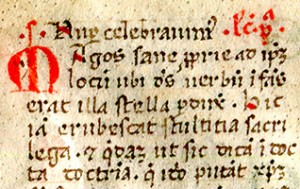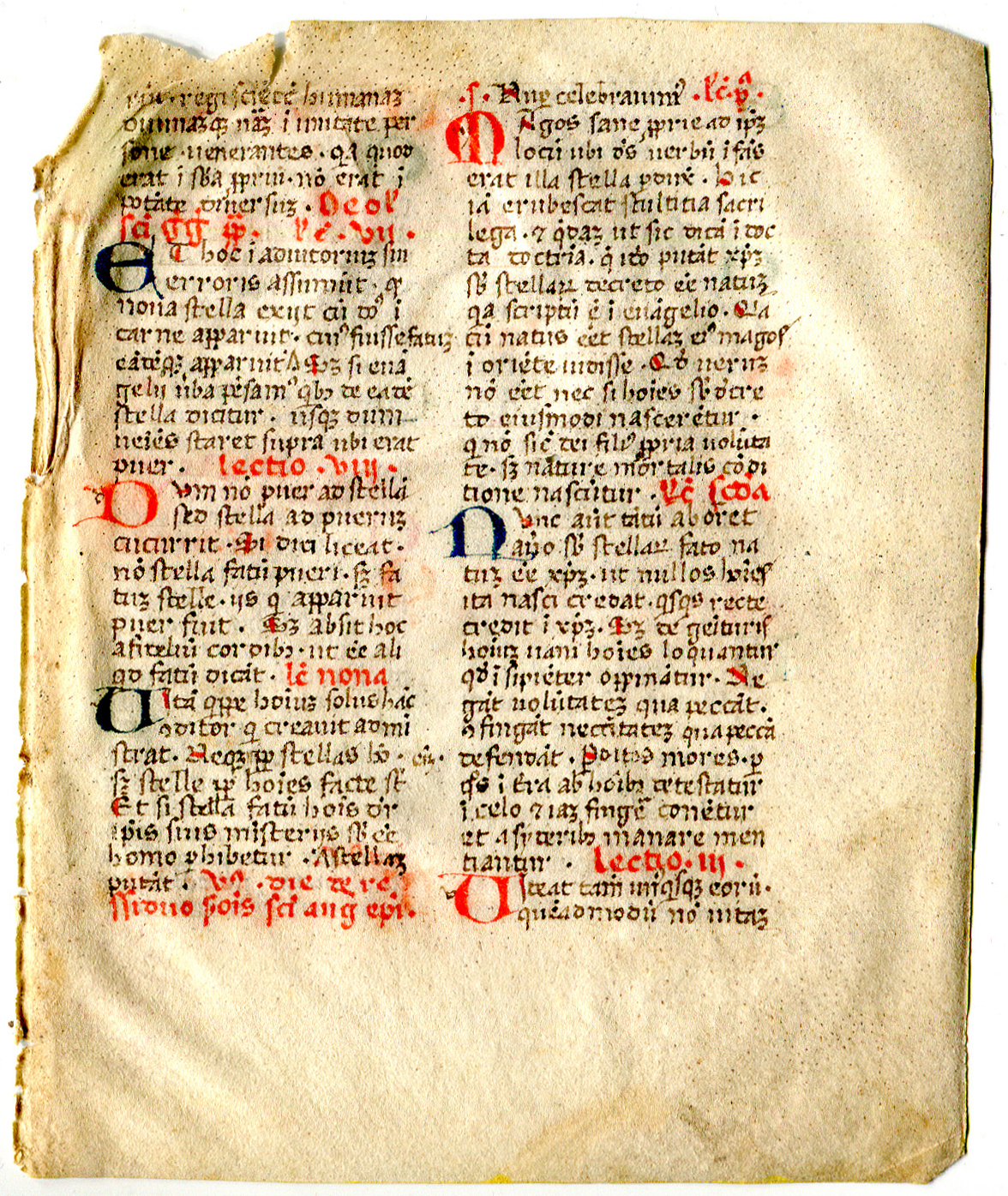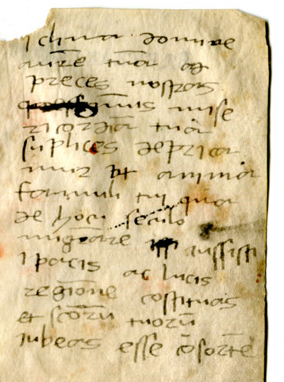Written in the Stars
April 21, 2016 in Manuscript Studies, Photographic Exhibition
Breviary Fragment with Latin Lections on Astrology
from Sermons by Patristic Authors,
plus a Prayer
[Published on 21 April 2016, with updates]
Our blog on Manuscript Studies observes a pair of consecutive leaves on vellum from the end of a 15th century Latin Breviary, possibly Italian, with a series of lections concerned with the nature of stellar determinism. All in favor of its rejection, all in favor of divine essence instead.
The Patristic authors of these extracts are by Pope Leo the Great, Gregory the Great, and Augustine of Hippo. Heavy hitters when it comes to rhetoric and theology, that’s for sure.
In a nutshell: The readings maintain that first Christ came to earth, and the stars followed. Not vice versa. So much for astrology, huh?
That a scrawling entry following those lections records a prayer for an unknown dead individual adds an extra resonance to the awareness of the fate of human beings on this earth. The original and added texts thus enter into a tacit form of dialogue on the themes of divine and human destiny.
Layout and Embellishment
Purchased online and now in a private collection, the 2 unnumbered vellum leaves (here called Folios ‘I’ and ‘II’ corresponding to their textual order) form a brief, dislocated statement, or set of statements. The layout of the leaves turns the somewhat darker hair side of the animal skin to the recto of Folio I and verso of Folio II, and the smoother, whitish flesh side to their facing sides in the opening between them (Folios Iv/IIr). The peppered surface of the hair side retains some black or brown hair follicles, presumably from cattle.
There seems no way of knowing how many leaves once stood in the quire to which these 2 leaves belonged, concluding the book. Perhaps other leaves survive which share the exact cutting line at the inner edge, demonstrating that they formerly conjoined these leaves in bifolia gathered into the quire.
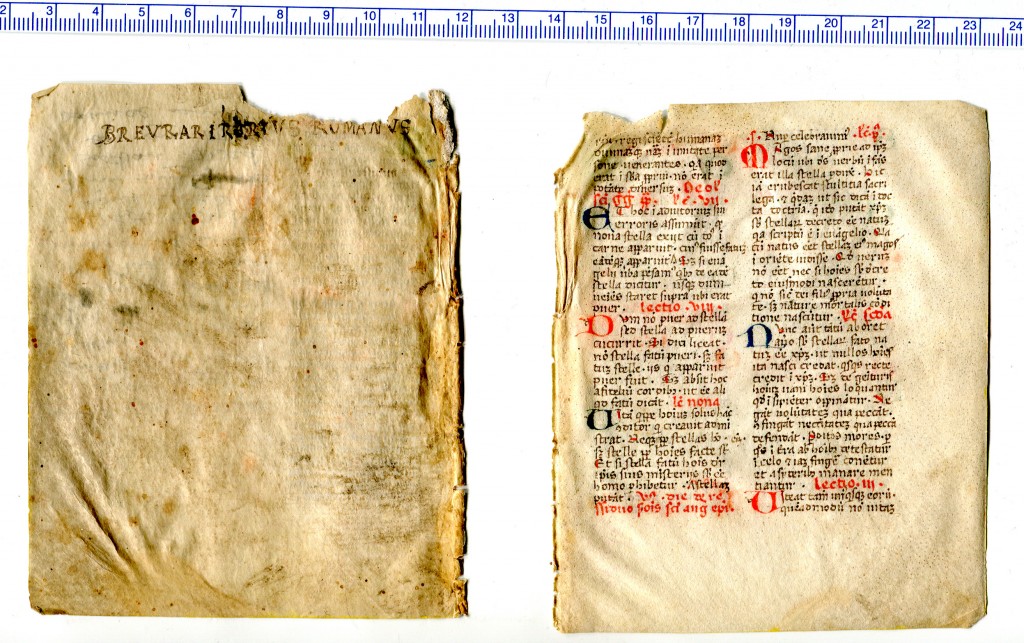
Recto of Bifolium with originally blank page and first surviving page of a set of Lections on Astrology by Augustine of Hippo and Gregory the Great. Reproduced by permission.
The original text is written in brown ink in double columns of 32 lines, with titles in red pigment and with 2-line inset initials alternately in blue and red pigments for the lections. A stroke of red pigment highlights the second letter after each initial and the initials of internal sections in each lection. The bright red pigment is probably vegetal, without the tarnishing, fading, or blackening characteristic of metallic red pigments. These simple bichrome elements provide the full extent of embellishment for a working text, at least insofar as its surviving portions show.
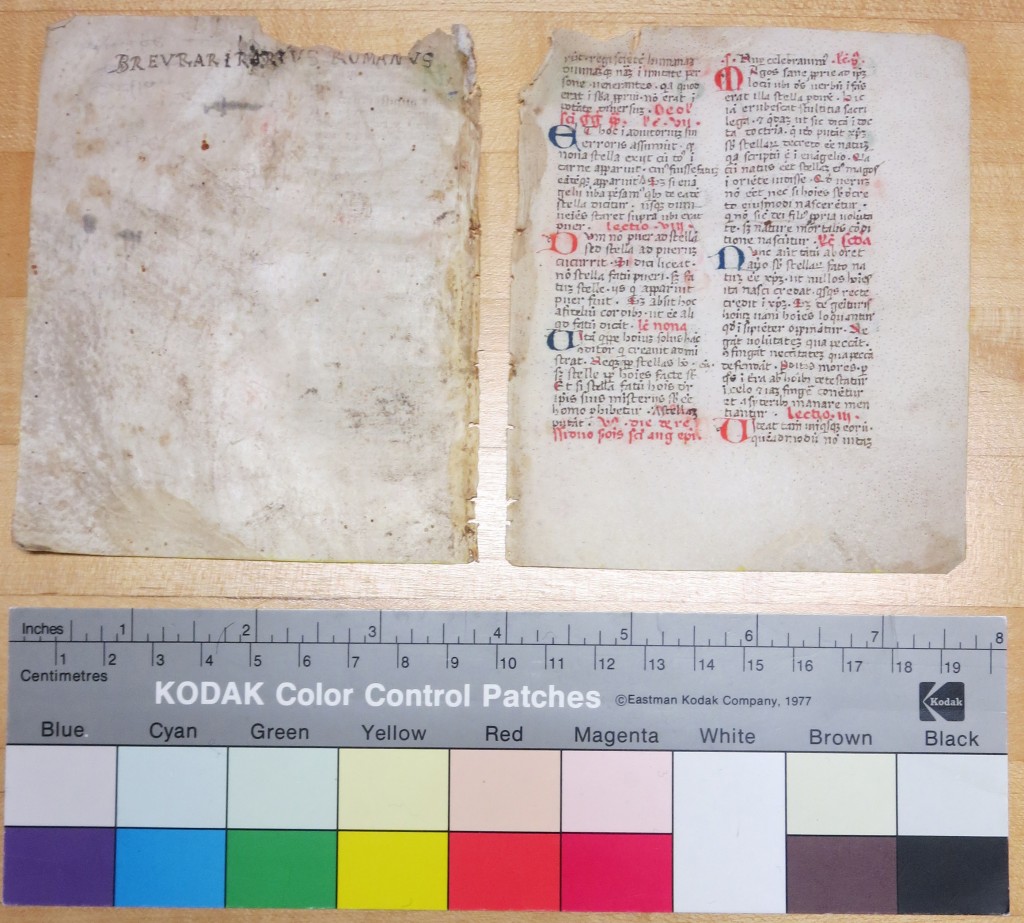
Breviary Fragment, Folios IIv/Ir, with the Revised Title and the Penultimate Page of the Lections. Color Guide and Scale included. Private Collection. Photography by Mildred Budny.
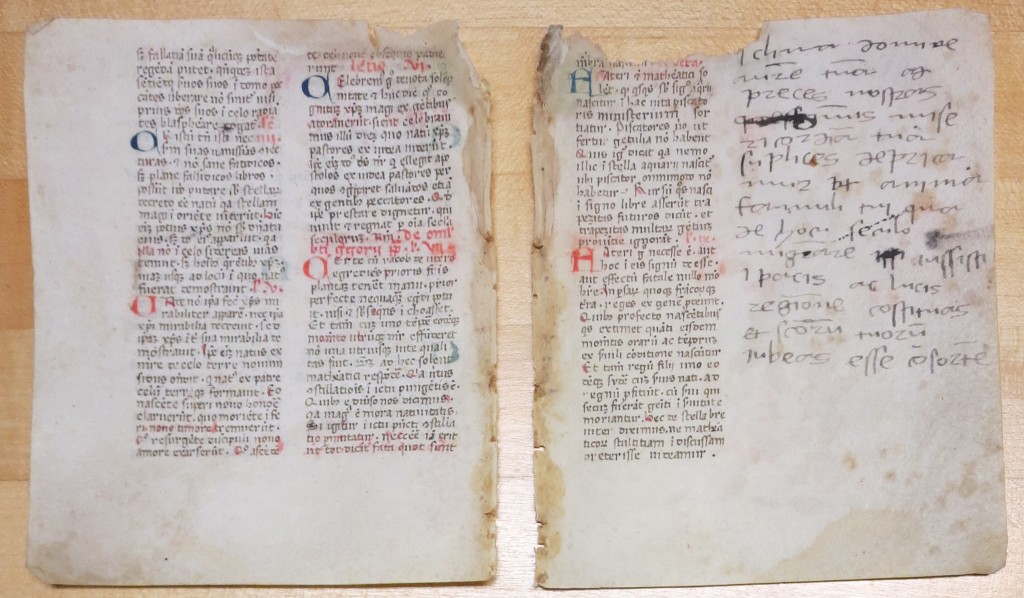
Breviary Fragment, Folios Iv/IIr, with the End of the Lections, plus a Note. Private Collection. Photography by Mildred Budny.
The script employs a somewhat uneven version of Revived Carolingian or Caroline Minuscule. A neater example that genre of script perhaps from Italy appears in an earlier blogpost.
A distinctive feature of this hand is the use of superscript dots, more-or-less centered over the letter, to indicate abbreviations, in place of the far more frequent more-or-less horizontal strokes for the purpose. (I do not know of a comparable case.) Written in the same ink, in the same process as the transcription of the text, smaller cue- or guide-letters set partly into the margin opposite their first inset line served to indicate the letter-forms for the enlarged and colored initials, which mostly overlie and mask these cues.
Taking Sides
Folio Ir
The Next Two Pages (Folios IIv/Ir), with the End of the Lections, plus a Note

Private Collection, Roman Breviary Fragment, Folios IIv/Ir, with the End of the Lections, plus a Note. Reproduced by permission.
The Back Page: Folio IIv
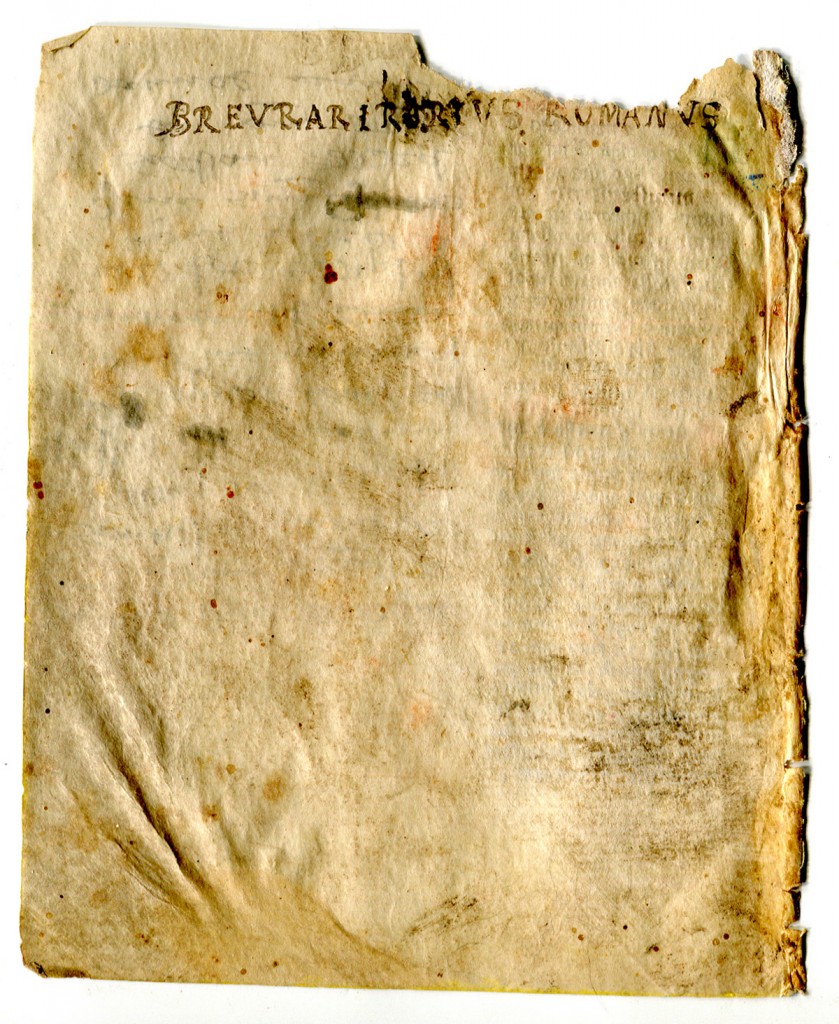
Folio IIv of Breviary fragment with a set of added titles or pen-trials on an originally blank page. Reproduced by permission.
Patristic Homiletic Texts for Lections:
Leo, Gregory, and Augustine versus Astrology
I. From Leo the Great to Gregory the Great
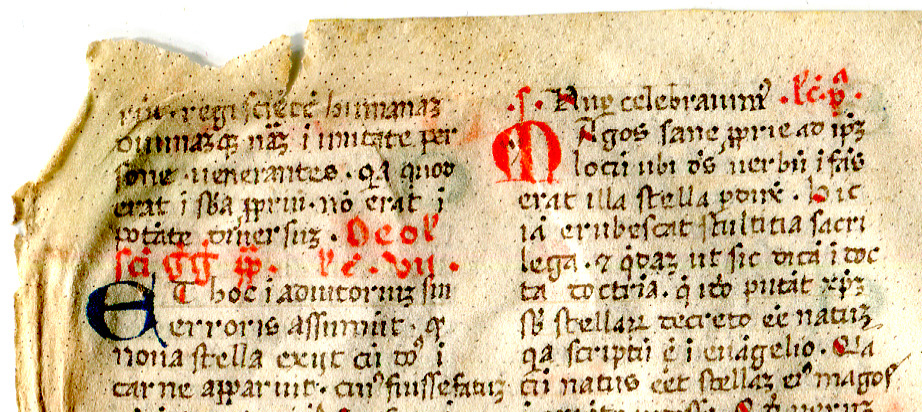
Detail of top of Folio Ir of Bifolium with the lfirst surviving page of a set of Lections on Astrology by Leo the Great, Gregory the Great, and Augustine of Hippo. Reproduced by permission.
1. Leo’s First Sermon on the Feast of Epiphany
Folio Ir opens abruptly, midword, within the last part of an extract from Sermon XXXI, Section 2, by Pope Leo I (pope from 440 to 461 CE). This is the first of his set of 8 Sermons delivered to the Roman People on the Epiphany, celebrated on 6 January in the Gregorian Calendar. As a feast of the Western Christian Church, Epiphany — meaning “manifestation” or “vision of God” — commemorates the visit of the Magi to the Christ Child, as it celebrates the revelation of God in his Son in human form, manifested thus to the Gentiles.
The surviving portion of the extract reads:
[aurum offe-/]
runt Regi scienter humanam
diuinamque naturam in unitate per-
sone uenerantes, quia quod
erat in substant[iis] proprium, non erat in
potentate diuersum.
(“. . . they [the Magi] offer the gold to the King, consciously paying honor to the Divine and human Nature in union: because while each substance had its own properties, there was no difference in the power of either.”)
In the old edition of the works by Leo the Great in the Patrologia Latina, the sermon appears in volume 54 (online as Leo I Magnus, Sermones), columns 254–257. This passage in Caput II (“Section II”) spans column 256 lines 29–30 plus column 257 lines 1–2. (Another online edition is here.) An English translation of the Sermon is available online.
II. From Pope Gregory to Bishop Augustine
2. Gregory’s Homily on Matthew 2:1–12:
Gregory’s Lections ‘Part I’
There follows an extract from Homily X on the Gospels by Gregory the Great (pope from 590 to 604). My earlier post reported on a lectionary fragment, probably from Italy, with the opening part of Gregory’s Homily XXXVIII from the same series of homilies, similarly in the company of a text by another author, albeit one much earlier chronologically and farther away geographically. That post provides references to editions and translations of Gregory’s 40 Homilies on the Gospels, traditionally presented as Books I and II of 20 homilies each. An online edition appears here, with Homily X here. A critical edition appears here and, with extended commentary and French translation, here.
This sermon was, according to its customary title, Habita ad populum in basilica sancti Petri apostoli, in die Epiphaniae (‘Delivered to the People in the Basilica of Saint Peter the Apostle on the Feast of the Epiphany’). Its first delivery took place on the day of that Feast, 6 January (Gregorian), in 591 CE.
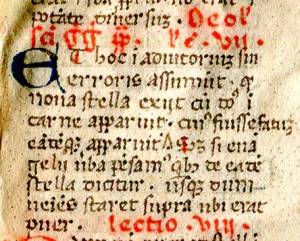 The extract is separated into 3 lections, labeled as Lectio (“Reading”) in full — or an abbreviation thereof (either l’ or lc’) — Numbers VII, VIII, and Nona (“Ninth”). The abbreviated title introducing the set identifies them as coming De omelia sancti gregorii papae (‘From the [or a] homily of Gregory the Great’). This particular homily considers verses 1–12 (out of 23) of Chapter 2 (translation here) in the Gospel of Matthew, where is described the visit of the 3 Magi, guided by a star, to the Christ Child.
The extract is separated into 3 lections, labeled as Lectio (“Reading”) in full — or an abbreviation thereof (either l’ or lc’) — Numbers VII, VIII, and Nona (“Ninth”). The abbreviated title introducing the set identifies them as coming De omelia sancti gregorii papae (‘From the [or a] homily of Gregory the Great’). This particular homily considers verses 1–12 (out of 23) of Chapter 2 (translation here) in the Gospel of Matthew, where is described the visit of the 3 Magi, guided by a star, to the Christ Child.
The series comes from part of Section 4 of the Homily, extending from et hoc in adiutorium sui erroris assumunt (“And they [that is, the followers of Priscillian, the Bishop of Avilia charged with sorcery and executed circa 380 CE] claim in support of their error . . . “) to Et si stella fatum hominis dicitur, ipsis suis ministeriis subesse homo perhibetur (“If a star is called the destiny of someone, that person is said to be subject to its control”). Translation by David Hurst (1990), page 57.
Tucked in at the end of the series, the omitted phrase stellam putant from line Ira11 has its place in lines Ira30–31, both directly following perhibetur and beginning the next line beside the title for the next author’s series. An identical pair of signes-de-renvoi, comprising a high dot and a lambda-shaped symbol ( •Λ ), signals the locations of both the supplied omission and its required insertion within the text. An observant reader might notice this sign within the text (between apparuit and cuius), recognize its significance (from other reading experiences of similar effects), and search upon the page for the matching mark, whether identical, mirrored, or other. The various genres of such signs are surveyed here.
Granted, the discreet positioning of this supplied omission within the text column itself may call for some assiduous searching. Certainly its positioning demonstrates that the scribe caught the mistake at some point in the transcription, before entering the rubricated title at the bottom of the column.
Two other, single-word, omissions have their nearby remedy in the intercolumn beside the very lines. For line Ira10, the line preceding the in-text •Λ-omission sign, the word fatum omitted between those 2 lines stands as an extension beyond the text-column, running into the end of the word (fuisse) which it should follow directly. This correction is the work of the scribe, perhaps in the course of transcription.
For line Ira26, an abbreviated enim aims for insertion between Neque and propter, where a smudged mark may mask a formerly clearer indication of such intent. This instance appears to belong to a different stage, such as text-correction, and perhaps to a different hand.
Such symptoms demonstrate an interest in transmitting the text accurately. While the leaves show signs of wear and tear, the sure sign of consulting the completed text, or at least using an available blank area to enter another one, occurs at the end of the lections (described below).
3. Augustine’s First Sermon on the Feast of the Epiphany
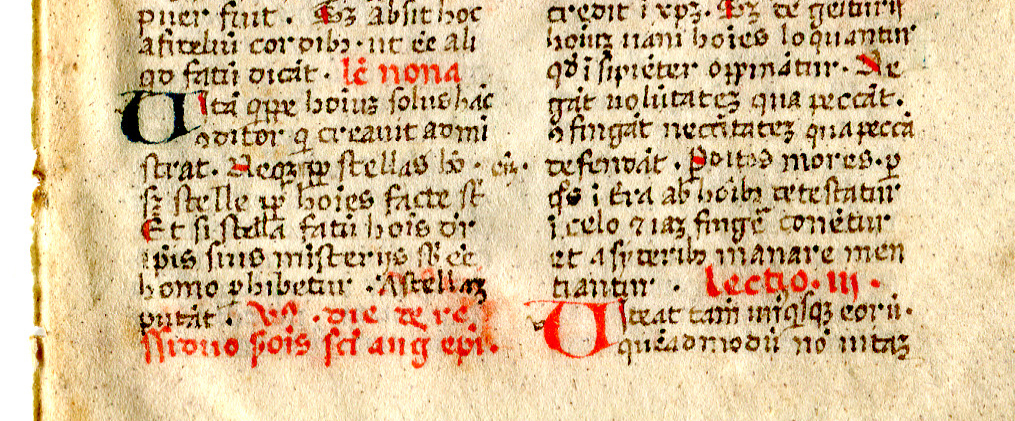
Detail of bottom of Folio Ir of Bifolium with the lfirst surviving page of a set of Lections on Astrology by Leo the Great, Gregory the Great, and Augustine of Hippo. Reproduced by permission.
Next comes a newly numbered series of lections — labeled as prima (‘first’), secunda (‘second’), III, IIII, V, and VI — from Sermon 199 by Augustine of Hippo (354–430 CE). With its titles, this series of lections extends from folio Ira31 to Ivb15.
The sermon is the first of Augustine’s 3 Sermons (Numbers 199–201) on the Epiphany. Online resources for its text include both an edition and English translation. A recent printed English translation appears in Augustine of Hippo, Sermons to the People: Advent, Christmas, New Year, Epiphany, translated by William Griffin (New York, 2002), as its no. 18. The main thrust of Augustine’s argument is a declaration of the shortcomings of astrology, with arguments against “stellar determinism” or “stellar dominance” advocated by pagan practitioners.
The Sermon, and this series, begins with Nuper celebrauimus (“Recently we celebrated . . . “, namely the day of Christ’s Nativity) — here functioning as a cue. The series of extracts jumps straight to Section 3 of the Sermon, beginning with Magos sane ad ipsum proprie locum ubi Deus Uerbum infans erat, illa stella perduxit . . . (“A star led the Magi to the precise place where God the [or as] Word was born”). The series completes its, and the Sermon’s, span thus: . . . per quos congregaret salvandos etiam ex Gentibus peccatores (“so that, through their [that is, the chosen Apostles’] instrumentality, He might gather into His fold the sinners who were to be saved from among the pagans”), ending in line Ivb12.
Without notice in the form of any title, there directly follows the liturgical doxology, rounding out the section:
Quod ipse prestare dignetur, qui vivit et regnat per omnia secula seculorum. Amen.
(“May He deign to grant this [grace], He who lives and reigns, world without end, Amen“)
4. Gregory’s Homily on Matthew 2:1–12, continued:
Gregory’s Lections, ‘Part II’
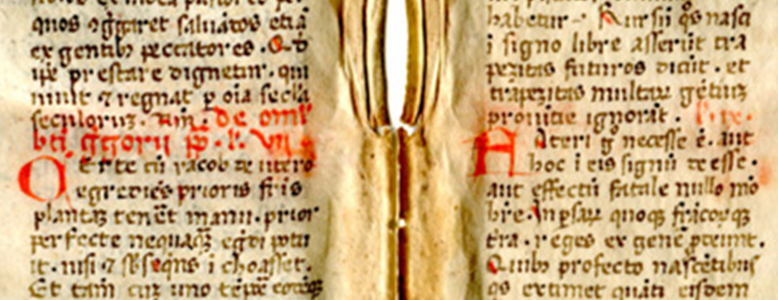
Detail of the midsection of Folios Ivb and IIra with the closing set of Lections on Astrology by Gregory the Great. Reproduced by permission.
Then the readings from Gregory’s Homily X resume, directly where they left off in their earlier series, to round out the set of lections. Their second series fills the lower half of the same column and the full first column on the next page (folios Ivb15 – IIra32), to leave the second column originally blank. Its lection numbers continue the same series as the Augustinian lections, picking up with the numbers VII, octa (‘eight’), and IX.
The extracts from the homily follow its sequence directly, picking up where the first series left off and continuing partway into Section 5 of the Homily. This series extends from Certe cum Iacob de utero egrediens (“When Jacob came out of his mother’s womb”) to Haec de stella breviter diximus, ne mathematicorum stultitia indiscussam praeterisse videamur (“I have said this briefly about the star so that I should not appear to have passed over the foolishness [stultitia] of the astrologers [Mathematicorum] in silence”). Translation by Hurst, page 58.
There is no concluding title. Over and out.
A Reader’s Added Prayer
Most of the originally blank column beside the conclusion of the lections is filled with a sprawling entry written in darker brown ink in 14 lines forming a broader column, which rises higher than the adjacent original column of text and descends as far as its line 25. Parts of the entry are crossed out messily with rough patches of dark ink, perhaps the same.
The addition records a prayer, partly legible, in a rough script — unpractised? — perhaps of the 15th or 16th century. The text is sufficiently legible to identify it as a Prayer for a Dead Man from the Roman Breviary.
With a couple of cancelled or corrected mistakes, the entry reads (expanding the abbreviations silently, but signalling an unmarked abbreviation within square brackets):
Inclina domine aurem tuam ad preces nostras quibus [a longer version of this word is partly cancelled with thick lines] misericordiam tuam supplices deprecamur ut animal famuli tui quam de hoc saeculo migrare [issi is crossed out] iussisti in pacis ac lucis regione co[n]stituas et sanctorum tuorum iubeas esse consortem.
(“Incline Thine ear, O Lord, unto our prayers, wherein we humbly pray Thee to show Thy mercy upon the soul of Thy servant, whom thou hast commanded to pass out of this world, that Thou wouldst place him in the region of peace and light, and bid him be a partaker with Thy Saints.”)
Who knows, perhaps a particular death, or its commemoration, prompted the entry. The absence of any name, or even the customary N for Nomen (“Name” to be supplied), within the Breviary record of the prayer lifts this version into a timeless, generalized sphere of reference.
A Revised Title on the Originally Blank Verso

Detail of top of Folio IIv of Breviary fragment with a set of added titles or pen-trials on an originally blank page. Reproduced by permission.
Originally blank, the last page carries stains of different kinds, from exposure at the back of the textual unit and proximity to the former back cover. Both on this leaf and its companion, the remains of whitish cord occupy some of the sewing stations for the former binding, or some former binding or resewing.
Two overlapping versions of a single-line title written in brown inks in relatively unskilled Capitals, in different stints and apparently by more than one hand, extend across the upper portion of the last page. Including the overlap and some retraced, smeared letters in darker ink over it, the title(s) spread more-or-less evenly across the page.
Blank pages at the ends of volumes, like blank pages within their span, often acquired entries of various kinds, related and unrelated to the text(s). Examples include pen-trials or doodles in many forms. Here, the doubled versions of the same or a similar phrase are less likely to be unrelated pen-trials than an effort, in stages and with stumbles or stutters, to name the nature of the contents of the book. Placing the title at the back conforms with some medieval practices, which opened books from their backs. For example, the placement of clasps on medieval bindings direct, and guide, such an approach.
Taken together, the entry calls the book a BREVRARIRO[?]RIVS ROMANUS. Not only does the darker script of the first half misspell the Latin word for Breviary, through repetitions of the RA-, RI-, and RO[?]– components, but also the whole thing mistakes the neuter word Brevarium for a masculine Brevra . . . rius, and thus fails to come up with the correct neuter adjective Romanum.
Anyway, the title(s) get(s) it more-or-less right by calling it a “Roman Breviary” (however misshapen), as the texts of the known surviving portions of the book conform with that widespread genre of liturgical book.
A Roman Breviary
A Breviary (Brevarium) denotes the genre of book containing all the texts for the Divine Office, whether recited in choir or in private. Providing the official set of prayers to mark the Hours of each day, it offers the texts of psalms, lessons from Scripture, writings of the Church Fathers, hymns, and prayers, in various order. Together, the Breviary and the Mass comprise the official life of public prayer in Western Christian practice. While the contents of breviaries exhibited differences — sometimes considerable — across various regions and periods of the Middle Ages, over time the Roman Breviary came to ascendance within Roman Catholicism.
Such is the form of book here. The 2 leaves from its end reproduce a thoughtfully selected set, or pair of 9 numbered sets, of interlinked lections from 3 of the Latin Church Fathers, concerned with the Magi’s visit to the Christ Child and with the star or stars as guides to destiny, or not. The first fragmentary set of the pair begins mid-word within its lection numbered 6. The pair does not carry the title for its liturgical occasion, but the contents might imply the Feast of the Epiphany. How and in which order the rest of the book presented its texts remain the subject for other quests, dependent upon the survivors and related compilations, insofar as they might be identified.
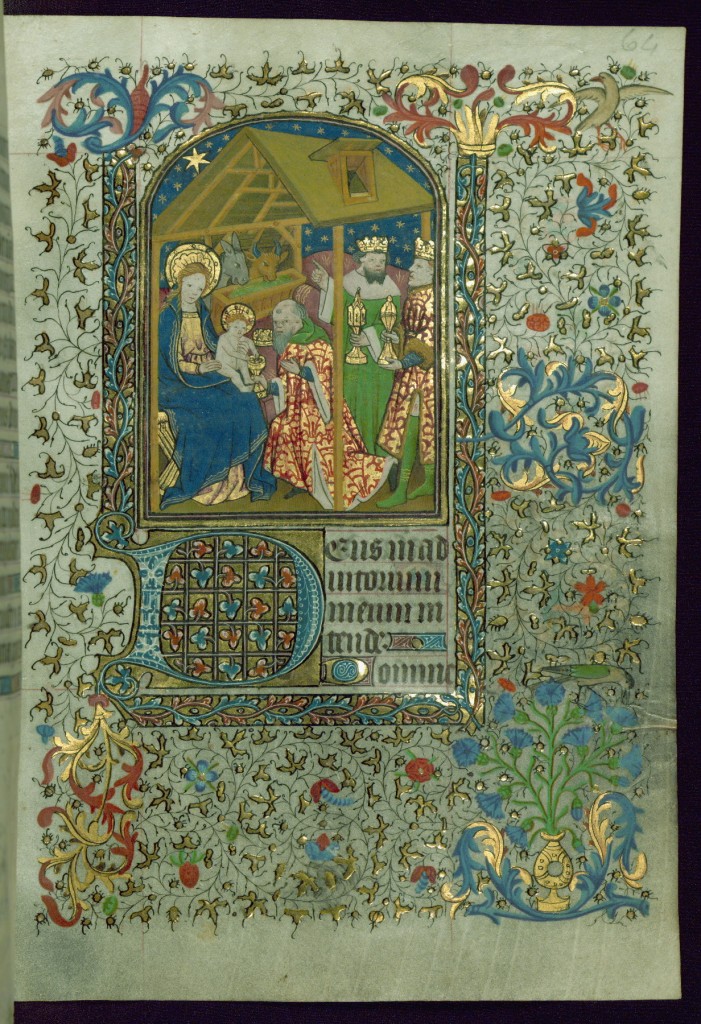
The Walters Art Museum, MS. W. 267, folio 64r, within the Hours of the Virgin. Via Creative Commons.
Book of Hours, made in Hainaut, France, circa 1450-1460.
*****
Suggestions for further reading:
- Mark Allan Powell, Chasing the Eastern Star: Adventures in Biblical Reader-Reponse Criticism (Louisville, Kentucky, 1989), especially Part 3: ‘Matthew’s Magi (An Extended Case Study)’, pages 13–185
- John Scott Lucas, Astrology and Numerology in Medieval and Early Modern Catalonia: The Tractat de pronostication de la vida natural dels hòmens (Leiden, 2003)
- Sophie Page, Magic in the Cloister: Pious Motives, Illicit Interests, and Occult Practices to the Medieval Universe. Magic in History (University Park, PA, 2013)
*****
Afterwords
While researching the 2 leaves, I have now learned that there exist some more leaves from the same book, although their locations are unknown to me. At least 14 more leaves were offered by the same seller — so a total of 16 (if not more) survivors are known, at least to some individuals.
Glimpses of small images produced by the seller suffice to show me that none of those others was the leaf immediately preceding “our” pair. That leaf would have concluded with the words aurum offe- within a lection VI (or perhaps sexta) from Leo’s Sermon XXXII, Section 2. A fuller study of the survivors might reveal more about the selections of lections, but I leave that work to others.
However, it remains to be said that, in general, the continuing practice of dismembering manuscripts and dispersing their remnants to the winds of commerce arouses disapproval in terms which might well call for the rhetorical power of some Patristic giants of oratory — as exhibited in the Breviary’s selections of lections countering, or at least disputing, the claims of astrology.
Earlier posts in our series on Manuscript Studies drew attention to the perplexing, wasteful issues of the dispersal of fragments without adequate documentation of their manuscript contexts — including the appropriate information to accompany the dispersed bits, if they must find different homes, rather than a single home for each manuscript’s group of fragments. Some posts express the plea for preserving and respecting the evidence:
The details differ, with the focus specifically upon the preservation of the evidence of manuscripts, even within their settled homes, but the plea in an earlier paper by our author has the same rallying call, grounded in practical experience:
Some of our posts describe the labor-intensive process of detecting and virtually assembling the surviving traces of specific dispersed manuscripts:
- A New Leaf from ‘Otto Ege Manuscript 41’
with part of the Dialogues of Gregory the Great from Flanders - A New Leaf from ‘Otto Ege Manuscript 61’
with part of a 32-line Latin Vulgate Pocket Bible from France - A New Leaf from ‘Otto Ege Manuscript 8’
with part of a Processional for Nuns from England - A New Leaf from ‘Otto Ege Manuscript 14’
with part of a 50-line Lectern Bible in the Vulgate Version from France or Flanders - New Testament Leaves in Old Armenian
with parts of the New Testament in bolorgir script of the 15th or 16th century CE.
Many scholars and collectors have become familiar with such pervasive problems, tasks, and potential successes in reconstituting losses, at least in part. Some of our blogposts cite their accomplishments.
Also, the Round-Table Discussion at our recent Symposium on Words & Deeds urged a clearer process of disclosure and, if possible, a measure of regulation, for the sources of manuscript fragments which reach changing hands. We look for improvements in responsible collecting and selling, worldwide.
*****
[Update in July 2018:
The opportunity to examine the leaves directly and to photograph them side by side, with a color guide and scale, has yielded additional views (now exhibited above). We thank the owner for permission to examine, photograph, reproduce, and publish these materials.
Update in August 2020:
More work on fragmentary materials which apparently came from the same collection at Büdingen Castle casts light on their patterns of transmission. See:
- Selbold Cartulary Fragments
- Vellum Bifolium from Augustine’s Homilies on John, reused as a cover for an Account Book for a Garden at Ysenburg on behalf of the Parish Church at Büdingen in Hessen.]

View of Büdingen: Engraving by Matthias Merian the Elder in Martin Zeiller, ‘Topographia Hassiae, et Regionum Vicinarum’ (Franckfurt am Mayn, 16 volumes, 2nd edition, 1655). Image via Wikimedia Commons.
*****
Do you know of other leaves from this book or by the same scribe, or cases of entries by the same annotators?
Please let us know. Please Contact Us!
Our blog continues to report discoveries. See its Content List.
*****

